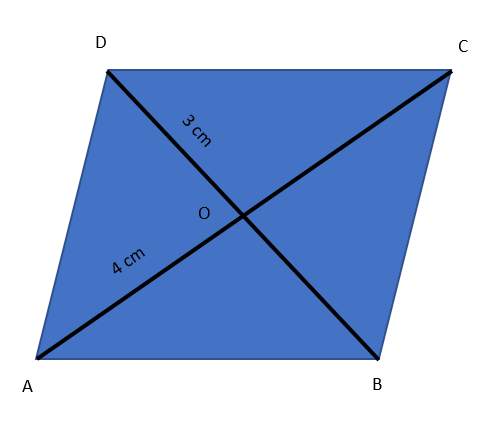Answer
405.6k+ views
Hint: We will first make use of the fact that the diagonals of a rhombus bisect each other at right angles. Then, we get a right angled triangle and thus on using the Pythagorean Theorem, we get the required answer.
Step-By-Step answer:
We are given that we have a rhombus ABCD.
We are also given that AO = 4 cm and DO = 3 cm.
Now, we also know that the diagonals of a rhombus bisect each other at right angles.
Therefore the angles corresponding to O that is angle AOD, AOB and so on are all right angles.
Now, we have got that $\angle AOD = {90^ \circ }$.
Now, consider the $\vartriangle AOD$:-
We have $A{D^2} = A{O^2} + D{O^2}$ (By Pythagorean Theorem)
[Pythagorean Theorem states that the sum of square of non – hypotenuse sides is equal to the square of the hypotenuse]
Now, we are already given the lengths of AO and DO.
$ \Rightarrow A{D^2} = {4^2} + {3^2}$
Solving the squares of the values in right hand side, we will get:-
$ \Rightarrow A{D^2} = 16 + 9$
Simplifying the values on the right hand side, we will then obtain:-
$ \Rightarrow A{D^2} = 25$
$ \Rightarrow AD = \pm 5$
Since, the length cannot be in negative terms, we then get:-
$ \Rightarrow AD = 5$
Now, since we know that the sides of a rhombus are all equal.
Therefore, AB = BC = CD = AD.
Therefore, all the sides are 5 cm each.
Perimeter of a rhombus is 4 times side length which can be written as:-
$ \Rightarrow $ Perimeter = $4 \times Side$
Putting the values of the side length we just obtained as 5 cm.
$ \Rightarrow $ Perimeter = $4 \times 5$cm
Simplifying the calculations on the right hand side, we then obtain:-
$ \Rightarrow $ Perimeter = 20 cm
Hence, the answer is 20 cm.
Note: The students must know that Perimeter is basically the total length of the sides. Here, in the rhombus ABCD, the perimeter is actually the sum of all sides AB, BC, CD and AD but since they are all equal in length, we get 4 times the side length.
Because Perimeter = AB + BC + CD + DA
(Since AB = BC = CD = AD)
$ \Rightarrow $Perimeter = AD + AD + AD + AD = $4 \times AD$
Hence, proved.
Step-By-Step answer:
We are given that we have a rhombus ABCD.
We are also given that AO = 4 cm and DO = 3 cm.
Now, we also know that the diagonals of a rhombus bisect each other at right angles.
Therefore the angles corresponding to O that is angle AOD, AOB and so on are all right angles.
Now, we have got that $\angle AOD = {90^ \circ }$.
Now, consider the $\vartriangle AOD$:-
We have $A{D^2} = A{O^2} + D{O^2}$ (By Pythagorean Theorem)
[Pythagorean Theorem states that the sum of square of non – hypotenuse sides is equal to the square of the hypotenuse]
Now, we are already given the lengths of AO and DO.
$ \Rightarrow A{D^2} = {4^2} + {3^2}$
Solving the squares of the values in right hand side, we will get:-
$ \Rightarrow A{D^2} = 16 + 9$
Simplifying the values on the right hand side, we will then obtain:-
$ \Rightarrow A{D^2} = 25$
$ \Rightarrow AD = \pm 5$
Since, the length cannot be in negative terms, we then get:-
$ \Rightarrow AD = 5$
Now, since we know that the sides of a rhombus are all equal.
Therefore, AB = BC = CD = AD.
Therefore, all the sides are 5 cm each.
Perimeter of a rhombus is 4 times side length which can be written as:-
$ \Rightarrow $ Perimeter = $4 \times Side$
Putting the values of the side length we just obtained as 5 cm.
$ \Rightarrow $ Perimeter = $4 \times 5$cm
Simplifying the calculations on the right hand side, we then obtain:-
$ \Rightarrow $ Perimeter = 20 cm
Hence, the answer is 20 cm.
Note: The students must know that Perimeter is basically the total length of the sides. Here, in the rhombus ABCD, the perimeter is actually the sum of all sides AB, BC, CD and AD but since they are all equal in length, we get 4 times the side length.
Because Perimeter = AB + BC + CD + DA
(Since AB = BC = CD = AD)
$ \Rightarrow $Perimeter = AD + AD + AD + AD = $4 \times AD$
Hence, proved.
Recently Updated Pages
When people say No pun intended what does that mea class 8 english CBSE

Name the states which share their boundary with Indias class 9 social science CBSE

Give an account of the Northern Plains of India class 9 social science CBSE

Change the following sentences into negative and interrogative class 10 english CBSE

Advantages and disadvantages of science

A Paragraph on Pollution in about 100-150 Words

Trending doubts
Which are the Top 10 Largest Countries of the World?

Select the word that is correctly spelled a Twelveth class 10 english CBSE

Fill the blanks with the suitable prepositions 1 The class 9 english CBSE

Difference between Prokaryotic cell and Eukaryotic class 11 biology CBSE

Give 10 examples for herbs , shrubs , climbers , creepers

Differentiate between homogeneous and heterogeneous class 12 chemistry CBSE

The Equation xxx + 2 is Satisfied when x is Equal to Class 10 Maths

Change the following sentences into negative and interrogative class 10 english CBSE

10 examples of law on inertia in our daily life




